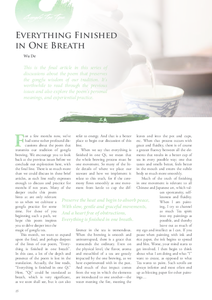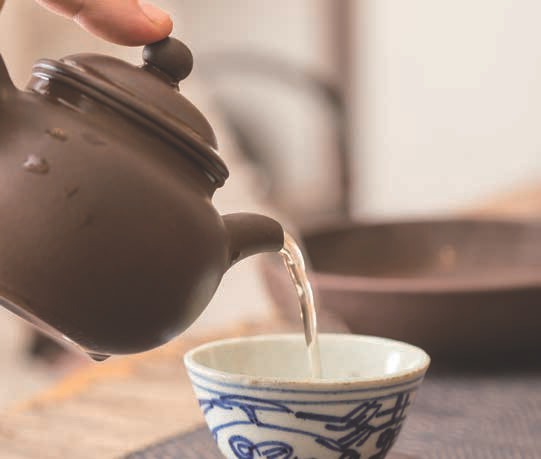
 |
|

Preserve the heat and begin to absorb peace, With slow, gentle and graceful movements, And a heart free of obstructions, Everything is finished in one breath.
For a few months now, we've had some rather profound discussions about the poem that transmits our tradition of gongfu brewing. We encourage you to look back at the previous issues before we conclude our exploration here, with the final line. There is so much more than we could discuss in these brief articles, as each line really expresses enough to discuss and practice for months if not years. Many of the deeper truths this poem hints at are only relevant to us when we cultivate a gongfu practice for some time. For those of you beginning such a path, we hope this poem inspires you to delve deeper into the magic of gongfu tea.
This month, we want to expand upon the final, and perhaps deepest of the lines of our poem, "Everything is finished in one breath". In this case, a lot of the depth and presence of the poem is lost in the translation. Actually, the line reads, "Everything is finished in one Qi." Here, "Qi" could be translated as breath, which is very significant, as we soon shall see, but it can also refer to energy. And that is a better place to begin our discussion of this line.
When we say that everything is finished in one Qi, we mean that the whole brewing process must be one movement. So many of the little details of where we place our teaware and how we implement it relate to this truth, for if the ceremony flows smoothly as one movement from kettle to cup the difference in the tea is tremendous. When the brewing is smooth and uninterrupted, there is a grace that transcends the ordinary. Even on the physical level, the flavor, aroma and mouthfeel of a tea are greatly impacted by the one brewing, as we have experimented with in the past. And much of that impact comes from the way in which the elements are introduced to one another—the water meeting the fire, meeting the leaves and into the pot and cups, etc. When that process occurs with grace and fluidity, there is of course a greater fluency between all the elements that results in a better cup of tea in every possible way; one that tastes and smells better, feels better in the mouth and enters the subtle body so much more smoothly.
Much of the truth of finishing in one movement is relevant to all Chinese and Japanese art, which values spontaneity, selflessness and fluidity. When I am painting, I try to channel as much Tea spirit into my paintings as possible, and thereby leave out as much of my ego and intellect as I can. If you pause when painting with ink and rice paper, the ink begins to spread and blot. Worse, your mind starts to get involved. I then begin to think about what I am doing and what "I" want to create, as opposed to what Tea wants to paint. Such scrolls are always inferior and most often end up as blotting paper for other paintings...
These principles apply to anything that requires mastery, from athletics to the arts. The best musical performances are fluid and free and force the artist(s) and the listeners out of the jailyard of personal routine. Similarly, when an athlete has something on his or her mind, they rarely perform well. It is only when he is "in the zone" that the great runner runs so extraordinarily.
Pauses are often a sign of trepidation, lack of confidence or surety, the absence of which will translate to the finished art—in this case the final cup of tea. When tea is prepared smoothly and calmly, without any break between the steps, there is a combining of elements and energies that creates harmony and depth.
There is also a lot that can be said for looking at this in terms of "...finished in one breath". Our breath is a magical source of insight, focus and concentration— one-pointedness of mind (Samadhi). The breath is one of the only bodily functions that can be controlled consciously or allowed to return to a natural rhythm that can be observed objectively by the mind, making it a powerful meditative tool for thousands of years. Any time I am upset or flustered in any way, my breath invariably changes. It is, therefore, also a gauge of my mind. Clearing the breath is clearing the mind, allowing us to brew tea from a place of Stillness beyond the mind. And when our efforts come out of such Stillness, then they of course invite our guests to find that Stillness in themselves. When any art, or even teaching, comes from a Still heart, it will also lead to that place in us when we view or listen to it.
Finishing the brewing in one breath can be literal. If we calm down and center ourselves, our breathing slows down and deepens. It is said that the best calligraphy is always brushed in a single breath. When one is very, very calm the movement from kettle to cup can happen in a single breath. But this cannot be forced. The poem is not referring to some kind of breathing exercise (other than perhaps using some breaths to calm down before lifting the kettle, as we discussed in previous articles in this series). When you are truly calm and centered, and all the movements are deft and graceful, happening without obstructions in the heart or hands, you will occasionally experience a steeping that aligns itself with a single inhalation/exhalation. The result is magical...
In trying to move towards finishing everything in one energy, one movement, we can begin to pay attention to the placement of our teaware and how we handle it in relation to such fluency. For example, if you haven't already, make a practice of always holding the kettle in the off-hand (viz., the left hand if you are right-handed). In that way, you can pour water over the leaves, shower the pot and then pick it up directly—in one single movement— as opposed to pouring and then setting the kettle down so that you can pick the pot up with the same hand, which is clunky and counterproductive to fluency. As you can see, the ability to "finish in one breath" is dependent upon ambidexterity. We must learn to center our body and use both hands equally if we are to master tea preparation with gongfu. Putting the largest of our tools in the off-hand also helps to facilitate strengthening it and balancing the two.
This month, try practicing using
both hands more. Try keeping the
kettle in the off-hand and then
switch so that you can notice the
difference. Hopefully, you will recognize
how much more smooth,
graceful and fluid tea brewing
becomes when you use both hands.
This also serves to preserve temperature,
as the first line suggests, since
brewing is quicker, and the whole
process is a single movement. Over
time, this frees the mind and opens
the heart—completing much of the
spirit the poem is pointing towards.
As always, email us with your
insights as a result of trying these
experiments!

